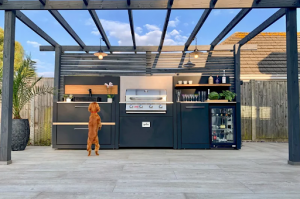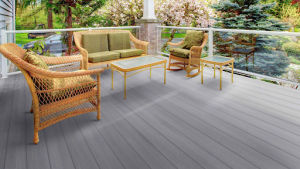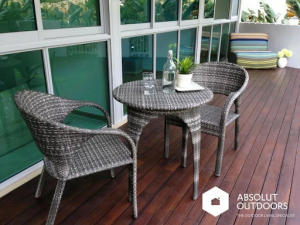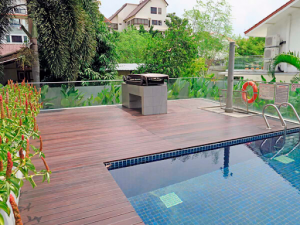The correct patio deck designs can mean the difference between an outside area that is just beautiful to look at and one that becomes a valid extension of your home when the weather is nice.
It can be amusing to welcome guests in your backyard, especially during the summer. Additionally, you can truly maximise the potential of your patio deck as a party area by including a few innovative decking ideas in its design.
To ensure that your backyard is a refuge for entertaining throughout the warmer months, we’ve picked up some of our favourite deck ideas with a social twist. Whether you’re seeking to host a BBQ, create an area for carefree summer evenings, alfresco dining, or even a party space.
1. Develop a Discussion Pit

Although conversation pits are most commonly associated with 1970s carpeting throwbacks in retro living rooms, this version gives a patio deck a contemporary edge.
According to the designer, Cortney McClure, “This clientele are in their mid-20s, and they love to host and entertain” (opens in new tab). Adding an open deck with a contemporary twist to the design was enjoyable. Because of the home’s distinctive architecture and the fact that the backyard serves as an extension of the house, a standard deck wasn’t going to do.
This unique seating arrangement not only simplifies the deck and makes the ideal space for partying but also saves you money on purchasing and storing garden equipment.
Remember to incorporate lighting into your plan; after all, you want to avoid taking a walk outdoors after dark and tripping over your seating area.
2. Zoning a Patio With a Deck

Even as a tiny garden idea, decks can effectively section off an outside area. A raised deck will help add levels, demarcate these spaces, and create a sense of flow in your backyard, where you’re incorporating distinct places created for different purposes.
Decks can help create usable areas in a garden when the ground may be uneven or even sloping.
However, the ease of usage of a raised deck will depend on how it is used. According to Steve Ritchey of San Francisco-based Seed Studio Environment Design, “A raised deck may make a powerful aesthetic statement and add a lot to the landscape if situated effectively, or it could seem fairly out of place and not be that comfortable to use if not thoroughly studied” (opens in new tab).
“This is true to a greater extent the higher it is about the surroundings.” However, occasionally you get the chance to do something bold, and I try not to shy away from that if the opportunity presents itself. I generally soften higher decks with numerous levels to gradually transition between the upper and lower places.
3. Extend Living Space From House

Even while not every house has a garden that is level with the place, the best outdoor living spaces allow for an almost seamless transition between inside and outdoor areas when the weather permits.
Compared to mounting steps and moving across the backyard, a raised deck aligned with the house creates a place that is simple to spill out into from home. And something that requires no effort is much more likely to be put to use.
Other advantages to this concept also exist. According to Nathan Fell, the owner of Nathan Fell Architecture, “While an elevated deck often offers some means of circulation to the rest of the yard, your design should, at the same time, take advantage of the prominent, heightened vista it affords” (opens in new tab).
With the addition of comfy seats and even a garden TV as part of this exterior restoration, the deck has transformed into an area that can be utilised for events and more casual entertaining.
4. Add a Patio Outdoor Kitchen

In recent years, outdoor kitchen concepts have taken off, and no party backyard would be complete without one. The ideal location for an outdoor kitchen is on a deck, providing you with a design option for bringing utilities into your outdoor area without disturbing the soil.
Think about how to make the most of a kitchen deck in your outdoor area. For instance, a larger countertop area will allow you to utilise it as a serving area for food and beverages. A refrigerator would save you from returning home to get ice.
The kitchen within your home can also apply the same design principles. Outdoor islands increase the social aspect of your outdoor cooking area by providing a place for guests to mingle with the cook of the day.
5. Create a Communal Seating Area

Some seating layouts are ideal for socialising, particularly when you require a location that can adapt and supply a few extra seats at a moment’s notice. Our best advice? Include stool seating in your plans for outdoor furniture.
Stools may double as side tables, take up little room on the deck when not in use, and are simple to store over the winter if necessary.
For the ideal gathering environment, please include them in a design that offers a choice of seating alternatives. When there is little space, it is better to use separate chairs rather than a single sofa because it makes it easier to face and interact with your guests.
Interior designer Marta Castellano(opens in new tab) designed an eclectic seating area with modern outdoor furniture ideas for this decking design for an apartment patio in Barcelona, including occasional chairs, a sofa, and even a swinging daybed.
6. Ensure That Comfort Comes First

No matter how much work you put into designing your outdoor area, if it isn’t cosy, no one will stay there for very long.
The key is comfortable furniture, but you may add more delicate items to make your room feel cosier. Choose cushions and blankets made of materials that will withstand the weather, advises Kristin Bartone of Bartone Interiors (opens in new tab). Your pillows won’t fade to a drab colour or become waterlogged if you use pillow inserts made of polyester and wrapped in indoor/outdoor fabric.
If you want to unwind on your patio deck, consider outdoor rugs, which can make the ground more comfortable.
Because cushions shouldn’t be left outside in all conditions, you should consider changing how you use the space if you don’t have enough garden storage space to store them.
According to Jamie Watkins, co-founder of the interiors company Divine Savages, “if, like us, you’re stuck for space to store cushions made specifically for the outdoors, we make it part of our daily routine to make our outdoor daybeds as comfortable and inviting as possible by bringing out our cushions from the living room.” It’s a quick, straightforward chore determining whether we sit indoors or outdoors.
7. Include a Pool Deck

If you’re fortunate enough to have a pool in your outside area, it’s sure to become a popular gathering spot for friends and family on weekends and special occasions.
One of the most significant possibilities is combining a deck design with a pool, which reduces trip dangers and creates an area suitable for both kids and adults to enjoy.
It may be enjoyable to walk on with bare feet because wood doesn’t carry heat and some hardscape materials, according to Ryan Prange, owner of San Diego-based landscape architects Falling Waters Landscape (opens in new tab). “The decking’s natural gaps offer superb drainage and slide resistance, too,”
It’s crucial to realise that wood will deteriorate more quickly near water, so consider the care and maintenance required for a timber pool deck and whether a composite substitute could be a better option.
8. Use Flow as a Guideline When Designing a Patio Deck

Making a garden inviting visitors is a big part of designing a wonderful space for entertaining, which goes far beyond the design elements you’ve added. It would help if you also considered how to create a modern garden in terms of how the area flows, how simple it is to move around in, and the vistas it offers.
You can create an elevated walkthrough to guide you through the area using a deck as part of the flow. According to Ryan Prange, a raised deck might serve as a main thoroughfare or corridor, and it “draws you out to a location” like a pier.
Stairs must also be carefully considered because their placement will affect how a deck integrates with the rest of the area. The best way to transition between floors is with wide steps that flank your patio deck.
According to Nathan Fell, the founder of Nathan Fell Architecture, “A very wide stair may seem counterproductive for furniture placement, but it is far more versatile since it enables various channels of circulation.” Wide steps are frequently used for more than just movement; they are more likely to be places where people sit, converse, and stay there rather than merely go through them.
9. Select The Appropriate Outdoor Lighting

Good outdoor lighting is essential to utilise your outdoor space for entertaining in the evening. Thankfully, there are just as many fantastic modern outdoor lighting ideas available today as there are for indoors. You can create a rich, layered system by combining floor-level lighting, freestanding, and overhead lighting.
Steve Ritchey of Seed Studio says, “Whatever type of lighting fixtures you use, make it a soft, warm-colour temperature light and provide the ability to dim to suit the moment.” This is crucial as it largely determines the vibe of your home and more can be found at 4 Ways Outdoor Lighting Benefit Your Home.
Designing a patio deck plan should take safety into account as well for visitors who might need to be more comfortable with the geography of your outdoor space when walking after sundown; using it to illuminate steps and level changes is crucial.
Final Thoughts
According to Ryan Prange of Falling Waters Landscape, start by considering the practical concerns. “For instance, Has the grade changed? Can you get a view without building concrete retaining walls by using a deck?
A deck can level up uneven landscapes and sloping gardens since it is raised off the ground on timbers. But constructing a deck requires more labour and money than establishing a patio, mainly when more expensive hardwoods are utilised.
Ryan explains, “Decking is a good alternative for getting into and out of the house. Stepping from timbers into a home has a certain charm. It is comfortable on the feet, frequently has wood flooring inside, and enables us to have a previous surface adjacent to the home to prevent problems with water against the siding or foundation.
Paving typically outlasts deck wood, especially less-than-stellar decking materials like pressure-treated wood. Outside of financial reasons, I don’t see a need for pressure-treated timber or plastic or composite materials for surface decking with the availability of thermally & acetylated treated woods. SGGoodWood will be able to help you regardless of the many ideas you might have in mind. SGGoodWood experience provides a good experience for our customers which can be found from reviews. Our experienced and skilled workers will be able to understand your respective needs regardless of Types of Wood Available. Contact us now for a quote!

